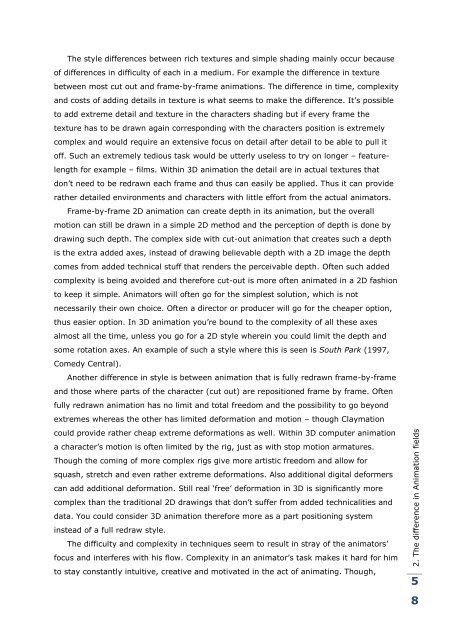Release. Pressure. Animate.
Release. Pressure. Animate.
Release. Pressure. Animate.
Create successful ePaper yourself
Turn your PDF publications into a flip-book with our unique Google optimized e-Paper software.
The style differences between rich textures and simple shading mainly occur because<br />
of differences in difficulty of each in a medium. For example the difference in texture<br />
between most cut out and frame-by-frame animations. The difference in time, complexity<br />
and costs of adding details in texture is what seems to make the difference. It‟s possible<br />
to add extreme detail and texture in the characters shading but if every frame the<br />
texture has to be drawn again corresponding with the characters position is extremely<br />
complex and would require an extensive focus on detail after detail to be able to pull it<br />
off. Such an extremely tedious task would be utterly useless to try on longer – feature-<br />
length for example – films. Within 3D animation the detail are in actual textures that<br />
don‟t need to be redrawn each frame and thus can easily be applied. Thus it can provide<br />
rather detailed environments and characters with little effort from the actual animators.<br />
Frame-by-frame 2D animation can create depth in its animation, but the overall<br />
motion can still be drawn in a simple 2D method and the perception of depth is done by<br />
drawing such depth. The complex side with cut-out animation that creates such a depth<br />
is the extra added axes, instead of drawing believable depth with a 2D image the depth<br />
comes from added technical stuff that renders the perceivable depth. Often such added<br />
complexity is being avoided and therefore cut-out is more often animated in a 2D fashion<br />
to keep it simple. Animators will often go for the simplest solution, which is not<br />
necessarily their own choice. Often a director or producer will go for the cheaper option,<br />
thus easier option. In 3D animation you‟re bound to the complexity of all these axes<br />
almost all the time, unless you go for a 2D style wherein you could limit the depth and<br />
some rotation axes. An example of such a style where this is seen is South Park (1997,<br />
Comedy Central).<br />
Another difference in style is between animation that is fully redrawn frame-by-frame<br />
and those where parts of the character (cut out) are repositioned frame by frame. Often<br />
fully redrawn animation has no limit and total freedom and the possibility to go beyond<br />
extremes whereas the other has limited deformation and motion – though Claymation<br />
could provide rather cheap extreme deformations as well. Within 3D computer animation<br />
a character‟s motion is often limited by the rig, just as with stop motion armatures.<br />
Though the coming of more complex rigs give more artistic freedom and allow for<br />
squash, stretch and even rather extreme deformations. Also additional digital deformers<br />
can add additional deformation. Still real „free‟ deformation in 3D is significantly more<br />
complex than the traditional 2D drawings that don‟t suffer from added technicalities and<br />
data. You could consider 3D animation therefore more as a part positioning system<br />
instead of a full redraw style.<br />
The difficulty and complexity in techniques seem to result in stray of the animators‟<br />
focus and interferes with his flow. Complexity in an animator‟s task makes it hard for him<br />
to stay constantly intuitive, creative and motivated in the act of animating. Though,<br />
2. The difference in Animation fields<br />
5<br />
8


